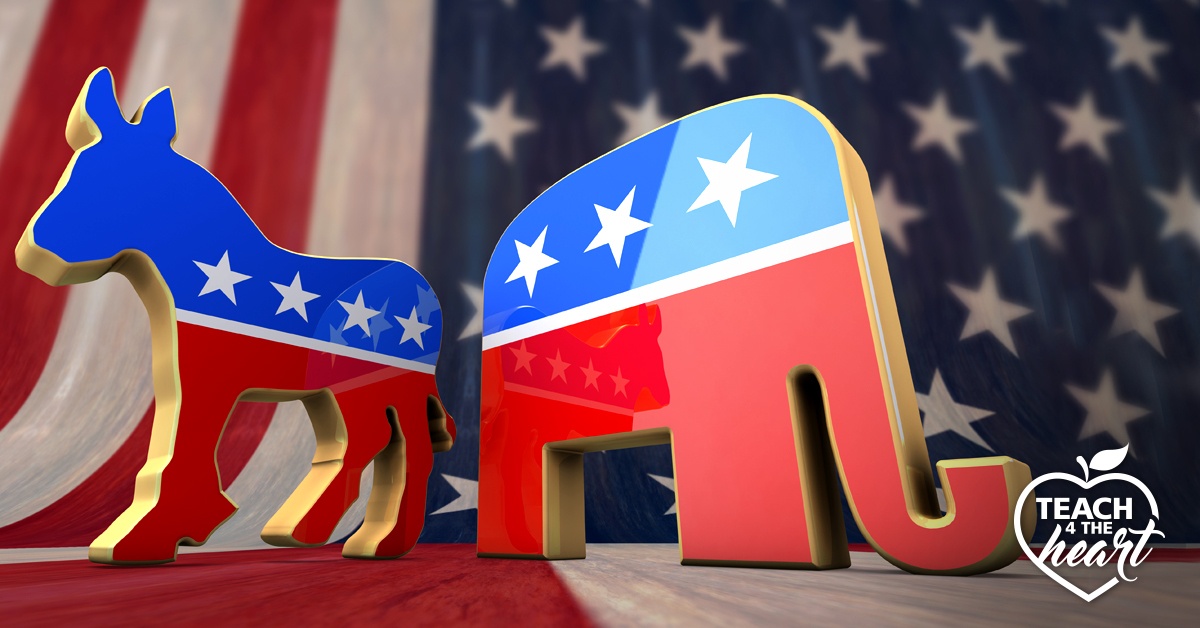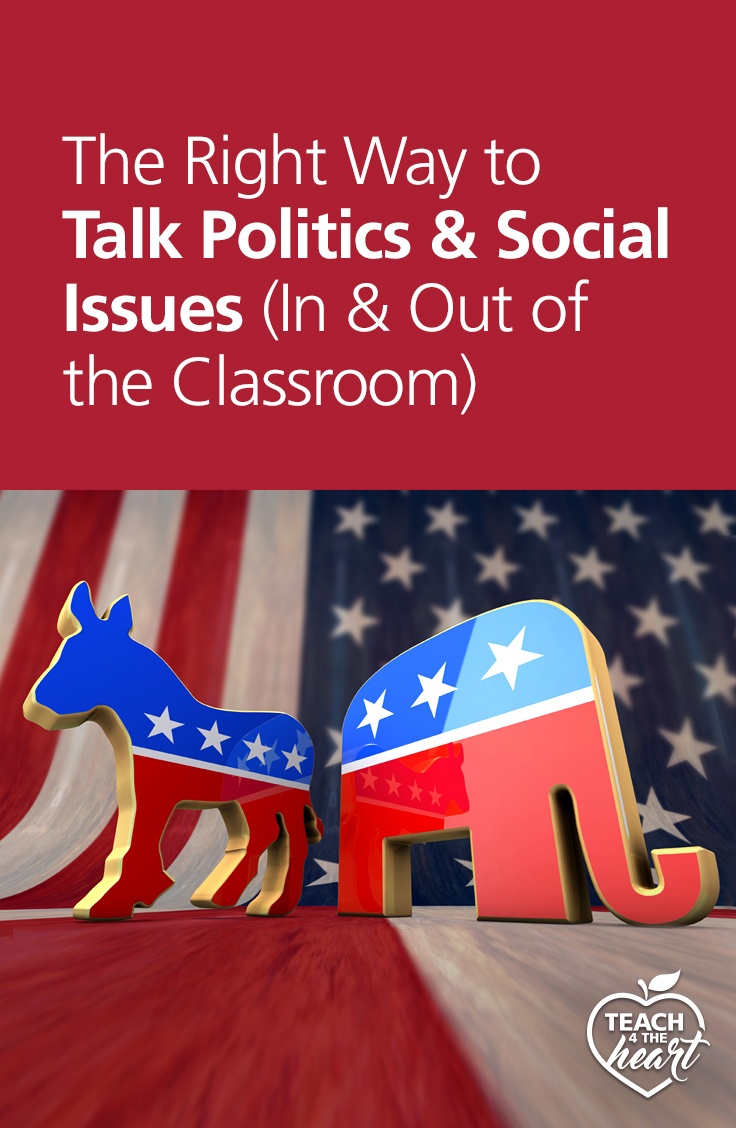
Oh my goodness what a year this has been!? We always knew an election year would bring up politics, but who knew the election would take a back to seat to COVID, the tragic killing of George Floyd, and so much more!
More than ever, we need to be able to talk about political & social issues in a way that is constructive and moves us towards actual solutions. And we need to model and proactively teach our students the right way to discuss controversial issues.
Listen to discover three key principles to talk politics & social issues the right way!
listen here:
discussing difficult issues
My husband, Tim, and I have really grown in our perspectives on this topic and are here to talk about everything we have learned. A lot of our growth comes from learning to trust in God’s Sovereignty and not put our trust in politics. Our hope is not in who is in the White House; it is in God. He is in control and our hope is found in Him. Though that’s not the focus of our conversation today, it's an important foundational principle.
We are in a tough spot right now in our country. More than ever, it is super divided and people seem unable to talk and come to any real solutions. We are talking “at” each other, rather than “with” each other. Some of you may have experienced this in your classrooms. We will discuss some contributing factors to this and then three key principles guiding how we should discuss politics.
Why are we so divided?
First of all, some of us grew up with the phrase, “Don’t talk about religion or politics.” Because of this, we never learned how to have a disagreement. The truth is, we need different viewpoints! We should be able to have these conversations and preserve relationships. When our country was founded, political and spiritual discussions were very commonplace.
In contrast to how we were raised, we now live in the era of social media. Social media gives you everything you “like” and agree with. It uses algorithms to give you articles you agree with because it knows your preferences and can see the pages you’re a fan of. When you come across something that has a different point of view, you can feel like no one could possibly think that way. In addition, social media is not a good forum for debate! There’s usually no relationship with the person you are debating with and you can’t read body language or tone.
how we should talk about politics
We have to be able to talk about the issues. How will we ever be able to find solutions if we cannot even talk about things? Our students also need to learn how to have these conversations to find solutions. Here are some guiding principles for discussing politics:
- We have to stop vilifying the other side. Everyone can look at the other side and find some truly horrible people there. However, the majority of people on both sides are truly trying to do the right thing; they just disagree about the methods.
In most issues, both sides think that they have the moral high ground. One example of this is the debate over illegal immigration. On one side, you have people saying, “You don’t care about these poor people trying to come to our country.” On the other hand are people saying, “You don’t care about laws, crime, or our society.”
The key here is that you don’t have to agree with the other person, but you don’t need to vilify them and think they are horrible because of their differing views. How could we ever understand someone else’s perspective if we think of them this way? Instead, start with the assumption that they do care. This should cause us to think, “I wonder why they think this way.” This leads us to our second point…
- We have to listen to each other. Steven Covey says, “Seek first to understand, then to be understood.” Before we can ever try to convince someone of our point of view, we have to genuinely understand why they think the way they do.
When those with differing viewpoints are talking, we often spend the time building our own arguments in our head instead of truly listening to them.
Before we share our perspective, we must truly listen and then reflect back by saying, “This is what I think you said…” Then, the other person had the opportunity to feel genuinely heard and understood.
Unfortunately, this rarely happens, but when it does, it’s powerful. You’ll discover lots of misconceptions on both sides. Once you clear those away, you’ll find that you have more in common than you realize, and you’ll clarify where the differences & sticking points are.
You’ll both come away better informed about the issue since you don’t really understand an issue until you understand both sides. Then, you can get to the core issue. This will allow you to better consider and discuss viable solutions.
- We have to think “both/and” rather than “either/or.” Some issues are clearly right and wrong, but most are more nuanced than that. We exasperate the divide and prevent ourselves from finding solutions by viewing things as “either/or” rather than “both/and.” This language comes from Ben Watson and his book, Under Our Skin.
Let’s look at the immigration issue again. One side is concerned about caring for immigrants and the other side is concerned about protecting Americans and helping those that are already here. The truth is that both goals are important. We need to be a haven for immigrants and those who need our help and protection, while also caring for Americans. The problem is that people are thinking in terms of “one or the other.” Both sides need to be part of the solution; it’s not an “either/or.”
Another example is the issue from a few years ago about kneeling during the national anthem. One side said, “We are doing this to call attention to injustice.” The other side said, “You’re disrespecting veterans, our flag, and our country.” Both sides said, “I’m right, you’re wrong.” Everyone was pointing fingers rather than truly listening to each other. The truth is that both concerns were valid and needed to be considered.
The last example is Black Lives Matter. We can and should both support police officers and hold them accountable. These sides shouldn’t be in opposition to each other; they’re both important. Acknowledging the other person’s view does not discount your own. It needs to be “both/and.”
I hope that as these issues come up in the classroom, you actively teach your students to avoid vilifying, give them opportunities to listen to each other, and demonstrate for them how to think “both/and.”
When these topics come up, ask your students questions that help them consider how and what the other side might be thinking. Teach that there are two sides to every issue and you can’t fully understand the issue until you understand both sides. These can be valuable lessons for the next generation.
spread the word!
Did you find this post helpful? Clue in your fellow teachers by sharing the post directly (just copy the URL) or by clicking one of the buttons to automatically share on social media.

This article may contain affiliate links. This means that if you purchase a resource after clicking the link, Teach 4 the Heart may receive a small commission at no extra cost to you. Thanks for helping support Teach 4 the Heart in this way.


beautiful article thanks you shared with us.
Look, I am going to be honest here… politics has NO place in schools or in the classroom.
I teach math and science. That is what brings me joy. No, I don’t talk about politics with my students. For me, there is no room in my classroom for what’s being shoved at us in a one sided fashion with the expectation that we try and indoctrinate students in our classroom with nonsense. (It’s mostly coming from the left.) No, science is not “racist”. Math is not “racist”. Yet we were forced to attend a “woke” professional development workshop focused on “white fragility in [insert whatever random topic].” We were made to feel that we are all inherent racists that uphold white supremacy because our subject areas are biased. I hope I am not the only one that feels that this is ridiculous. Is everyone just too scared to speak up for fear of losing their job?
The protests, violence, spike in crime, erasure of history, and civil unrest have nothing to do with the murder of George Floyd any longer. Some well intentioned far left liberal teachers organized what they call an “anti racist task force” where they passed around a list signing up teachers to read that “White Fragility” book by Robin DiAngelo. Names, emails, and phone numbers were taken down. No, I did not put my name on that list and I don’t care what anyone says. Someone needs to stand up to this insanity that has taken over our schools. I thought this was only in public schools but it’s spilled over into private schools (where I work) as well.
We talk more about these polarizing and self-deprecating topics than about God.